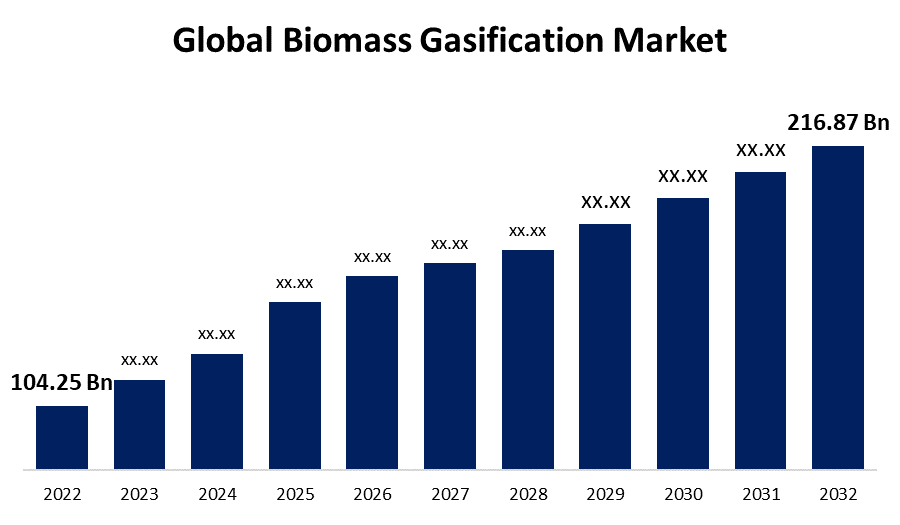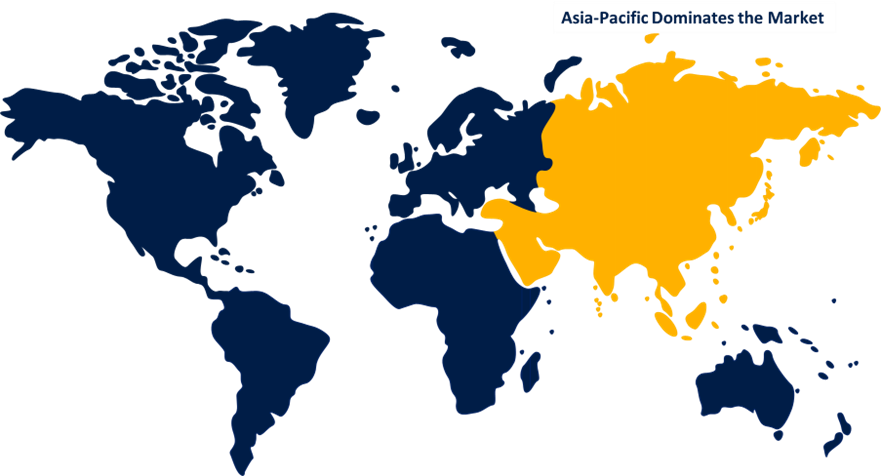Global Biomass Gasification Market Size, Share, and COVID-19 Impact Analysis, By Source (Agricultural Waste, Forest Waste, Animal Waste, and Municipal Waste), By Technology (Fixed Bed Gasifier, Fluidized Bed Gasifier, Entrained Flow Gasifier, and Others), By Application (Power Generation, Chemicals, Transportation Fuels, Hydrogen Generation, Ethanol, and Biochar), By Region (North America, Europe, Asia-Pacific, Latin America, Middle East, and Africa), Analysis and Forecast 2023 - 2032
Industry: Energy & PowerGlobal Biomass Gasification Market Insights Forecasts to 2032
- The Global Biomass Gasification Market Size was valued at USD 104.25 Billion in 2022.
- The Market is growing at a CAGR of 7.6% from 2023 to 2032
- The Worldwide Biomass Gasification Market Size is expected to reach USD 216.87 Billion by 2032
- Europe is expected to grow the higher during the forecast period

Get more details on this report -
The Global Biomass Gasification Market Size is expected to reach USD 216.87 Billion by 2032, at a CAGR of 7.6% during the forecast period 2023 to 2032.
Market Overview
Biomass gasification is a process that converts organic materials, such as agricultural residues, forestry waste, and energy crops, into a mixture of gases known as syngas. It is a promising renewable energy technology that offers an alternative to fossil fuels and helps reduce greenhouse gas emissions. In biomass gasification, the biomass is subjected to high temperatures in an oxygen-limited environment, causing it to break down and release a combination of hydrogen, carbon monoxide, carbon dioxide, and methane. Syngas produced through this process can be used for various applications, including electricity generation, heat production, and as a feedstock for the production of biofuels and chemicals. Biomass gasification holds great potential for sustainable energy production and contributes to the shift towards a cleaner and more sustainable future.
Report Coverage
This research report categorizes the market for global biomass gasification market based on various segments and regions and forecasts revenue growth and analyzes trends in each submarket. The report analyses the key growth drivers, opportunities, and challenges influencing the global biomass gasification market. Recent market developments and competitive strategies such as expansion, product launch, and development, partnership, merger, and acquisition have been included to draw the competitive landscape in the market. The report strategically identifies and profiles the key market players and analyses their core competencies in each sub-segments of the global biomass gasification market.
Global Biomass Gasification Market Report Coverage
| Report Coverage | Details |
|---|---|
| Base Year: | 2022 |
| Market Size in 2022: | USD 104.25 Billion |
| Forecast Period: | 2022-2032 |
| Forecast Period CAGR 2022-2032 : | 7.6% |
| 2032 Value Projection: | USD 216.87 Billion |
| Historical Data for: | 2019-2021 |
| No. of Pages: | 200 |
| Tables, Charts & Figures: | 130 |
| Segments covered: | By Source, By Technology, By Application, By Regionand COVID-19 Impact Analysis |
| Companies covered:: | Goteborg Energi AB, Valmet Corporation, Thyssenkrupp AG, KASAG Swiss AG, Ankur Scientific Energy Technologies Pvt. Ltd., Vaskiluoto Voima Oy, Beltran Technologies, Inc., Chanderpur Works Private Limited, Infinite Energy Pvt. Ltd., and EQTEC PLC. |
| Pitfalls & Challenges: | COVID-19 has the potential to impact the global market |
Get more details on this report -
Driving Factors
The biomass gasification market is driven by several factors such as increasing demand for renewable energy sources and the growing concern over climate change are major drivers. Biomass gasification provides a sustainable alternative to fossil fuels, reducing greenhouse gas emissions and promoting environmental sustainability. The government initiatives and supportive policies play a crucial role. Many countries are implementing renewable energy targets and offering financial incentives, tax benefits, and subsidies to promote biomass gasification projects. The abundant availability of biomass feedstock, such as agricultural residues, forestry waste, and energy crops, fuels the market growth. Additionally, advancements in gasification technology, such as improved efficiency, scalability, and cost-effectiveness, are driving market expansion. Furthermore, the versatility of syngas produced from biomass gasification, which can be used for power generation, heat production, and biofuel production, contributes to the market's growth. Overall, these drivers propel the adoption of biomass gasification as a sustainable energy solution worldwide.
Restraining Factors
The biomass gasification market faces certain restraints that impede its growth, the high initial capital investment required for setting up biomass gasification plants is a significant restraint. The technology and infrastructure costs associated with gasification systems can be substantial, making it less attractive for investors. The complex nature of biomass feedstock and the need for consistent and reliable supply pose challenges. The availability and quality of biomass resources may vary, affecting the efficiency and reliability of gasification processes. Overall, the lack of awareness and limited technical expertise in biomass gasification among end-users and stakeholders hinder market expansion. Overcoming these restraints requires addressing financial barriers, improving biomass supply chain management, and enhancing knowledge dissemination and training programs within the industry.
Market Segmentation
- In 2022, the forest waste segment accounted for around 31.5% market share
On the basis of the source type, the global biomass gasification market is segmented into agricultural waste, forest waste, animal waste, and municipal waste. The forest waste segment has emerged as the leader, holding the largest market share in the biomass gasification market. The forest waste, such as logging residues, sawdust, and forest thinnings, is abundant and readily available in many regions. This availability ensures a consistent and reliable feedstock supply for biomass gasification projects. The utilizing forest waste for gasification offers multiple benefits. It helps in managing and reducing forest waste, which otherwise might contribute to environmental concerns. Additionally, using forest waste as a feedstock is considered sustainable as it does not compete with food production or agricultural land. The, forest waste often has high energy content, making it a valuable resource for producing syngas. Moreover, technological advancements in gasification systems have improved their ability to efficiently convert forest waste into syngas. The forest waste segment's large market share is a result of its abundant availability, environmental advantages, and favorable characteristics for biomass gasification processes.
- In 2022, the chemical segment dominated with more than 37.5% market share
Based on the type of application, the global biomass gasification market is segmented into power generation, chemicals, transportation fuels, hydrogen generation, ethanol, and biochar. The chemical segment has emerged as the dominant player, holding the largest market share in the biomass gasification market. This can be attributed to several factors because biomass gasification provides a valuable source of syngas that can be used as a feedstock for the production of various chemicals. Syngas produced through biomass gasification can be further processed to produce a wide range of chemicals, including methanol, hydrogen, ammonia, and synthetic natural gas. These chemicals find applications in industries such as fertilizers, pharmaceuticals, plastics, and synthetic materials. Secondly, the growing demand for sustainable and renewable chemicals has driven the adoption of biomass gasification as a preferred method for chemical production. Biomass feedstocks used in gasification are considered renewable and contribute to a circular economy approach. Overall, advancements in gasification technology and process optimization have improved the efficiency and cost-effectiveness of chemical production from biomass gasification. These factors have propelled the chemical segment to dominate the market share in the biomass gasification market.
Regional Segment Analysis of the Biomass Gasification Market
- North America (U.S., Canada, Mexico)
- Europe (Germany, France, U.K., Italy, Spain, Rest of Europe)
- Asia-Pacific (China, Japan, India, Rest of APAC)
- South America (Brazil and the Rest of South America)
- The Middle East and Africa (UAE, South Africa, Rest of MEA)
Asia-Pacific dominated the market with more than 40.7% revenue share in 2022.

Get more details on this report -
Based on region, the Asia-Pacific region has emerged as a dominant player in the biomass gasification market, holding the largest market share. This can be attributed to growing population and rapid industrialization have resulted in a significant demand for energy. Biomass gasification offers a renewable and sustainable solution to meet this increasing energy demand while reducing reliance on fossil fuels. The countries like China and India, with their abundant biomass resources, have been actively investing in biomass gasification projects to diversify their energy mix and reduce carbon emissions. Moreover, supportive government policies and incentives promoting renewable energy have further propelled market growth in the region. Additionally, the Asia-Pacific region has witnessed technological advancements and collaborations, leading to improved gasification efficiency and cost-effectiveness. These factors collectively contribute to the region's dominance in the biomass gasification market.
Recent Developments
- In May 2022, Valmet's new pre-treatment Biotrac pilot facility has launched at the fibre technology centre in Sundsvall, Sweden. The pilot plant investment would assist Valmet improve its research and development capabilities in the field of biomass pre-treatment, as well as respond to market demand for bioenergy, biofuels, and biochemicals.
Competitive Analysis:
The report offers the appropriate analysis of the key organizations/companies involved within the global biomass gasification market along with a comparative evaluation primarily based on their product offering, business overviews, geographic presence, enterprise strategies, segment market share, and SWOT analysis. The report also provides an elaborative analysis focusing on the current news and developments of the companies, which includes product development, innovations, joint ventures, partnerships, mergers & acquisitions, strategic alliances, and others. This allows for the evaluation of the overall competition within the market.
List of Companies:
- Goteborg Energi AB
- Valmet Corporation
- Thyssenkrupp AG
- KASAG Swiss AG
- Ankur Scientific Energy Technologies Pvt. Ltd.
- Vaskiluoto Voima Oy
- Beltran Technologies, Inc.
- Chanderpur Works Private Limited
- Infinite Energy Pvt. Ltd.
- EQTEC PLC.
Key Target Audience
- Market Players
- Investors
- End-Users
- Government Authorities
- Consulting and Research Firm
- Venture Capitalists
- Value-Added Resellers (VARs)
Market Segment
This study forecasts revenue at global, regional, and country levels from 2019 to 2032. Spherical Insights has segmented the global biomass gasification market based on the below-mentioned segments:
Biomass Gasification Market, By Source
- Agricultural Waste
- Forest Waste
- Animal Waste
- Municipal Waste
Biomass Gasification Market, By Technology
- Fixed Bed Gasifier
- Fluidized Bed Gasifier
- Entrained Flow Gasifier
- Others
Biomass Gasification Market, By Application
- Power Generation
- Chemicals
- Transportation Fuels
- Hydrogen Generation
- Ethanol
- Biochar
Biomass Gasification Market, Regional Analysis
- North America
- US
- Canada
- Mexico
- Europe
- Germany
- UK
- France
- Italy
- Spain
- Russia
- Rest of Europe
- Asia Pacific
- China
- Japan
- India
- South Korea
- Australia
- Rest of Asia Pacific
- South America
- Brazil
- Argentina
- Rest of South America
- Middle East & Africa
- UAE
- Saudi Arabia
- Qatar
- South Africa
- Rest of Middle East & Africa
Need help to buy this report?